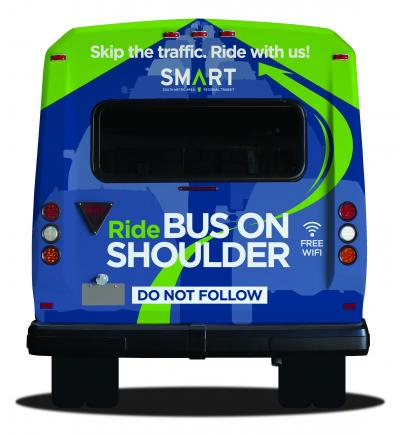Bus on Shoulder Project
Bus on Shoulder Pilot Project in Wilsonville - Project kick off event
OVERVIEW
The Oregon Department of Transportation (ODOT) is collaborating with South Metro Area Regional Transit (SMART) to support more reliable travel by using the highway shoulder for transit vehicles. This innovative concept is referred to as Bus on Shoulder.
The pilot project extends approximately two miles in both directions of I-5 between the I-205 interchange and Elligsen Road. Authorized buses may use the shoulder in clearly marked areas when traffic drops below 35 mph.
No other vehicles are authorized to use road shoulders to bypass traffic. Emergencies always take priority in use of the shoulder.
WHO
SMART is the only authorized transit provider to use the shoulder for this pilot project. SMART's experienced and highly trained bus operators will undertake additional training to support safe and efficient travel in the corridor.
WHY
Bus on Shoulder is a low-cost multi-modal transportation solution used throughout the country with proven results including safe and cost-efficient means of addressing congestion.
ODOT’s goals for this pilot are to create a more reliable transit commute and promote improved transit accessibility. With less time on the road, vehicles will emit fewer emissions, helping support cleaner air in the community.
With small, but clear adjustments to road striping and other signage, Bus on Shoulder supports more efficient travel on Oregon’s freeways without large infrastructure improvements that can take years to be realized. This Bus on Shoulder pilot project maximizes use of existing transportation infrastructure and planned highway maintenance, reducing the needed resources for implementation.
HOW
In the designated 2-mile stretch of highway, buses may merge onto the shoulder if and when the traffic drops below 35 mph. Buses may drive up to 15 miles per hour faster than the flow of traffic in the main lanes, up to a maximum speed of 35mph.
Cars, trucks and other non-emergency vehicles must remain in the designated highway lanes, and are not permitted to use the shoulder unless it’s an emergency, to avoid large highway debris, or to make room for a passing emergency vehicle.
Emergencies take priority over buses. Transit operators are required to yield the shoulder to all emergency vehicles and to merge back into the main traffic lanes. Bus operators encountering an emergency will report back to dispatch so that subsequent operators on those routes are made aware of the obstructions ahead of time.
ODOT website
tinyurl.com/i5busonshoulder.com
.





